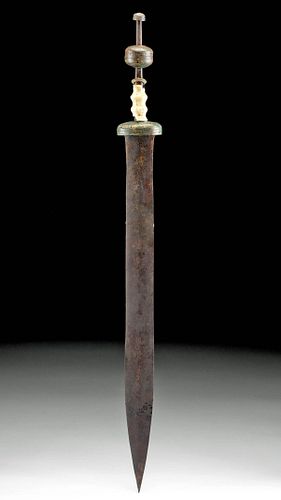Roman Iron Spatha w/ Bronze Pommel, Ivory Handle
Lot 55
About Seller
Artemis Gallery
686 S Taylor Ave, Ste 106
Louisville, CO 80027
United States
Selling antiquities, ancient and ethnographic art online since 1993, Artemis Gallery specializes in Classical Antiquities (Egyptian, Greek, Roman, Near Eastern), Asian, Pre-Columbian, African / Tribal / Oceanographic art. Our extensive inventory includes pottery, stone, metal, wood, glass and textil...Read more
Categories
Estimate:
$12,000 - $18,000
Absentee vs Live bid
Two ways to bid:
- Leave a max absentee bid and the platform will bid on your behalf up to your maximum bid during the live auction.
- Bid live during the auction and your bids will be submitted real-time to the auctioneer.
Bid Increments
| Price | Bid Increment |
|---|---|
| $0 | $25 |
| $300 | $50 |
| $1,000 | $100 |
| $2,000 | $250 |
| $5,000 | $500 |
| $10,000 | $1,000 |
| $20,000 | $2,500 |
| $50,000 | $5,000 |
| $100,000 | $10,000 |
| $200,000 | $20,000 |
About Auction
By Artemis Gallery
Mar 24, 2022
Set Reminder
2022-03-24 10:00:00
2022-03-24 10:00:00
America/New_York
Bidsquare
Bidsquare : Exceptional Antiquities Ethnographic Fine Art
https://www.bidsquare.com/auctions/artemis-gallery/exceptional-antiquities-ethnographic-fine-art-9057
Museum-worthy examples of classical antiquities (Egyptian, Greek, Roman, Near Eastern), Viking, Far East / Asian, Pre-Columbian, African / Tribal, Oceanic, Native American, Spanish Colonial, Fossils, Ancient Jewelry, Fine / Visual Arts, so much more! Artemis Gallery info@artemisgallery.com
Museum-worthy examples of classical antiquities (Egyptian, Greek, Roman, Near Eastern), Viking, Far East / Asian, Pre-Columbian, African / Tribal, Oceanic, Native American, Spanish Colonial, Fossils, Ancient Jewelry, Fine / Visual Arts, so much more! Artemis Gallery info@artemisgallery.com
- Lot Description
Roman, Imperial Period, ca. 2nd to 4th century CE. A beautiful forged iron spatha of a bifacial design bearing a shallow midrib, extremely sharp edges, and a pointed tip. Situated along the tang are a hollow bronze hand guard with incised striations surrounding the flat face beneath the slightly convex topside, a hand-carved elephant ivory handle grip with a wavy design meant to accommodate a soldier's fingers, an adjustable ringlet with a sharp central carination, and a macaron-shaped pommel with incised striations around the midsection. The tip of the tang is fitted with a petite bronze cap that would have aided in holding all of these components in place in antiquity. Size: 30.6" L x 2.8" W (77.7 cm x 7.1 cm); (blade): 23" L x 1.8" W (58.4 cm x 4.6 cm)
The spatha was one of the most prevalent and widely used weapons in the ancient Roman Empire. According to professor of anthropology Michael D. Coe, "The spatha was of Celtic origin. The Romans were exclusively infantrymen, relying on their allies for cavalry. During the Gallic War, Caesar raised huge bodies of cavalry in Gaul. The Gallic tribes were also the target of Augustus' recruiting efforts when he started to form regular cavalry units to serve alongside the legions operating in the Rhineland. These units were equipped in native fashion with mail shirt, helmet, oval shield, and spear, and the long slashing sword that was to become the spatha, the primary weapon of the middle and later Empire." (Coe, Michael D. et al. "Swords and Hilt Weapons." Barnes & Noble, Inc., New York, 1996, p. 28)
Cf. The British Museum, museum number 1851,0806.2
Provenance: private Henderson, Nevada, USA collection, acquired via family lineage from grandfather who acquired it in Spain before 1939 during the Spanish Civil War
All items legal to buy/sell under U.S. Statute covering cultural patrimony Code 2600, CHAPTER 14, and are guaranteed to be as described or your money back.
A Certificate of Authenticity will accompany all winning bids.
PLEASE NOTE: Due to recent increases of shipments being seized by Australian & German customs (even for items with pre-UNESCO provenance), we will no longer ship most antiquities and ancient Chinese art to Australia & Germany. For categories of items that are acceptable to ship to Australia or Germany, please contact us directly or work with your local customs brokerage firm.
Display stands not described as included/custom in the item description are for photography purposes only and will not be included with the item upon shipping.
#170670Blade, guard, pommel, and handle grip are possibly not original to one another but are all from the stated time period. All components were likely cleaned at one time. Repair to remaining ivory grip and roughly 2" portion of hand guard's rounded face closest to handle grip, with resurfacing on guard repairs, and light adhesive residue on guard and handle grip. Losses to portions of ivory handle grip as shown. Slight bending to overall form of blade with deformation and abrasions to tip, and light oxidation commensurate with age across blade and tang; cap adhered to end of tang. Abrasions and nicks to bronze components, with encrustations and softening to some finer details. Ivory handle grip has yellowing to surface coloration and extensive craquelure. Hand guard, handle grip, and ringlet all move freely along the tang. Nice patina throughout.Condition
- Shipping Info
-
All shipping is handled in-house for your convenience. Your invoice from Artemis Gallery will include shipping calculation instructions. If in doubt, please inquire BEFORE bidding for estimated shipping costs for individual items.
-
- Buyer's Premium



 EUR
EUR CAD
CAD AUD
AUD GBP
GBP MXN
MXN HKD
HKD CNY
CNY MYR
MYR SEK
SEK SGD
SGD CHF
CHF THB
THB














